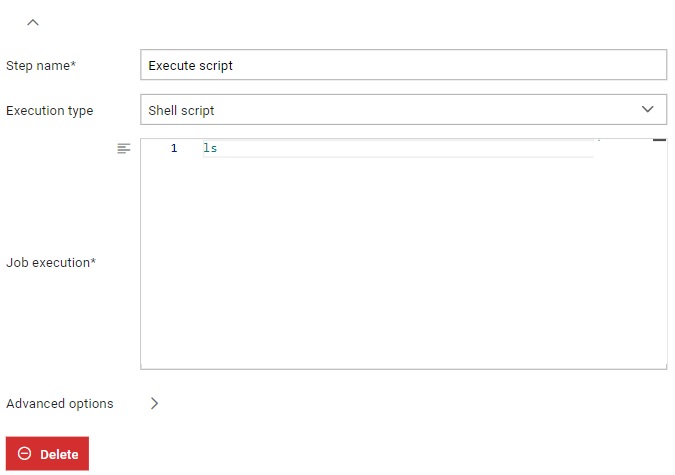Execute script
Overview of the Execute script job step, which allows for executing shell scripts.

The Execute script job step makes it possible to run shell scripts during a job. From the job step settings (Figure 1), you can customize information about the job step, including:
- A custom step name can be defined; otherwise, the default step name will be used
- Execution type: This can be a Shell script or a batch command.
- Job execution: Enter the Execution command which should be
executed. Next to the Job execution field, button
 enables text wrapping of the commands entered in the
field.
enables text wrapping of the commands entered in the
field. - Every step has Advanced options through which steps can be
managed. When execution of the step fails, execution of the job continues. If
option Abort job on step fail is marked, Job execution will stop once this step
fails and further steps will not be executed. When it comes to skip condition,
it allows skipping the current step if the condition is met.
Expression of the condition can include:
- a basic scenario, such as entering True/False directly or using an expression like 1 == 1.
- variable/value exist check - if the user adds
$parameter_name to the if clause, the Job
will be executed as long as the parameter name is
defined.
- variable can be referenced by using any of the following formats: ${parameter_name}, %parameter_name%, {{parameter_name}}, and $parameter_name.
- variable equal(==)/not equal(!=) to a certain value - if the user adds $parameter_name == some_value to the if clause and the values match, the Job will be executed.
- variable containing(~~)/not containing(!~) a certain value - if the user adds $parameter_name ~~ some_value and the value or parameter_name contains some_value, the Job will be executed.
- Within the execute if condition user can use environment variable AGENT_OS if needed, and create a condition based on the Agent's operating system.
Figure 2. Execute script job step with advanced options shown 
Note: In order to save a form, all input fields must be valid. Required fields are signed
with *.
Note: When script finishes its execution, it will result with a status code. This code is an
integer value that represents a response from the OS that reports success, an error or
another condition that provides a clue about what caused an unexpected result from the
executed command or script. For example, if the script finishes successfully OS will
result with status code 0, which means that your command/script has executed and exited
without any problems or errors.
Note: When using a Windows batch script, if an error occurs, the script will not stop its
execution; it will finish, and the status will be passed. This is a standard behavior
because batch files do not terminate automatically if a command fails with an error
(inherited from MS-DOS). They do terminate if there is a syntax error within the file.
If you need to check the behavior of a specific command, you can add the following code
after the line you expect to fail to inspect the behavior of the error.
IF %ERRORLEVEL% NEQ 0 (
EXIT /b 1
)Note: Please note that only one typhoon-python command
can be executed per job execution step with Windows Batch script. If you need to execute more than one typhoon-python command,
you can add multiple execution steps to the job definition. Alternatively, you can use the
call batch command, as shown in the code snippet below, which allows calling typhoon-python multiple
times within the same execution step.
call typhoon-python -m pytest "tests/demo_tests" From inside a script, it is possible to update notes or tags of an execution. Following
command updates execution notes:
update-tth-execution --notes execution_id "new notes value"update-tth-execution --tags execution_id "first tag, second tag"Additionally, report notes can also be modified from the script. Following command
updates report notes:
update-tth-report --notes report_id "new notes value"